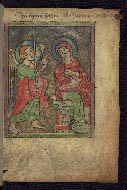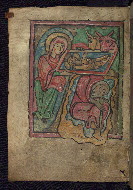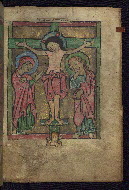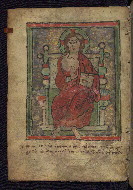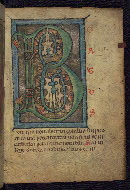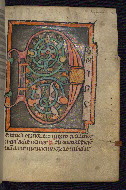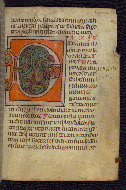Home > Digitized Walters Manuscripts
This document is a tranformation of a TEI P5 XML manuscript description incorporating images. If you have trouble reading special or non-Latin characters on this page, please make sure you have appropriate Unicode fonts installed and an up-to-date web browser.
Walters Ms. W.69, Psalter of St. Mary of Strasbourg
Browse images (Browse images in a new window) | TEI in XML format
W.69
Psalter of St. Mary of Strasbourg
This Latin psalter was made in the second half of the thirteenth century for use in the Diocese of Constance, Germany. By the fourteenth century, it was owned by the church of St. Mary of Strasbourg, from which it gets its name. The long life and enthusiastic use of the manuscript is attested to by a multitude of added inscriptions, prayers, and antiphons with neumes, most dating to the fifteenth or sixteenth century. An early system of bookmarking is also evident; strips of parchment have been cut in some of the margins and folded through a slit in the leaf, creating tabs that would have helped the reader navigate through the text. Illumination also served this function, for while a short cycle of images from the life of Christ introduces the manuscript, the rest of the illuminations--large decorated initials as well as smaller ones in silver and gold--mark the important psalms for the reader. The style of illumination found here is closely related to two other psalters from Constance: Sigmaringen, Royal State Archives Ms. 11 and Fulda, Hessische Landesbibliothek Fulda Ms. Aa 82.
Second half of the 13th century CE
Upper Rhineland, Germany
Book
Devotional
The primary language in this manuscript is Latin.
Parchment
Medium- to heavy-weight parchment; edges of folios dark brown; early (possibly original?) parchment tabs, created by cutting a strip of parchment from the margin and looping it back through a slit, mark important text divisions
Foliation: i+135
Two sets of foliation: early pen foliation written in roman numerals in upper right corners of rectos and modern pencil foliation in the same location (followed here); front flyleaf early but not original, foliated (not structurally integral to the first quire)
Formula: i, 1(2), 2-4(8), 5(10,-3,7), 6(8,-1), 7-11(8), 12(10,-3,7), 13-16(8), 17(10,-3,7), 18(4), 19(2)
Catchwords: None
Signatures: None
Comments: Quires begin on fols. 2(1), 4(2), 12(3), 20(4), 28(5), 36(6), 43(7), 51(8), 59(9), 67(10), 75(11), 83(12), 91(13), 99(14), 107(15), 115(16), 123(17), 131(18), 135(19); last folio of quire 18 tipped to the first folio of the quire later in the thirteenth century, at the same time that quire 19 was added
13.7 cm wide by 19.4 cm high
10.3 cm wide by 14.7 cm high
- Columns: 1-2
- Ruled lines: 21
- Ruling not visible; layout does not apply to added prayers on fol. 136v
- Title: Psalter
- Text note: Psalter, canticles, and litany thirteenth century; prayers added to blank folios at the back, fifteenth or sixteenth century; German antiphons and neumes added occasionally throughout, e.g. fols. 24r, 32r, 34r, etc.; additional notes found in margins throughout
- Hand note: Written in pre-Gothic bookhand; antiphons added in margins in cursive bookhand; front and back pastedowns in Gothic bookhand; Office of the Dead and added prayers in other hands
- Decoration note: Four full-page miniatures; one large inhabited initial (18 lines); three large decorated initials (12-18 lines); eight small silver and gold initials (5-7 lines); red flourished initials throughout; rubrics in red; text in black ink
- Title: Prefatory cycle
- Decoration note: Full-page miniatures on fols. 2r-v and 3r-v
- Title: Psalter
- Incipit: Beatus vir
- Text note: Gallican Psalter with three-part division at Ps. 1 (fol. 4r), Ps. 51 (fol. 41v), and Ps. 101 (fol. 80r); lesser division at Ps. 109 (fol. 92r) and at the eight liturgical psalms (which include Ps. 1): Ps. 26 (fol. 21v), Ps. 38 (fol. 32r), Ps. 52 (fol. 42r), Ps. 68 (fol. 52v), Ps. 80 (fol. 66v), Ps. 97 (fol. 78r), and Ps. 118 (fol. 96v)
- Decoration note: Inhabited initial on fol. 41v; large decorated initials on fols. 4r, 80r, and 92r; small silver initials on fols. 21v, 32r, 42r, 52v, 66v, 78r, and 96v
- Title: Canticles, Pater Noster, and Apostles' Creed
- Rubric: Ysajas
- Incipit: Confitebor tibi domine
- Contents: Fols. 119r-128r: Canticles; fol. 128v: Pater Noster; fols. 128v-130v: Apostles' Creed
- Decoration note: Small silver and gold initial on fol. 119r
- Title: Litany and collects
- Rubric: Letania
- Incipit: Kyrie eleyson
- Text note: Notable saints in litany connected to Constance: SS. Pelagi, Aureli, Conrade, and Verena; some Swiss and south German saints also present: SS. Placide, Odalrice, Afra of Augsburg, Othmare of St. Gall, Findane, Walpurga, and Regula; collects incomplete
- Title: Plainchant hymn to Mary
- Rubric: Oratio sancta Maria
- Incipit: Ave beatissima civitas divinitatis
- Text note: Added later to blank part of folio
- Title: Office of the Dead: Vespers
- Rubric: Vespere defunctorum
- Incipit: Placebo domino in regione
- Text note: Text added (very early addition) to blank folios; incompletely copied at end
- Hand note: Written in Gothic bookhand
- Title: Added prayers
- Text note: Many different prayers by several fifteenth- or sixteenth-century hands, added to an originally blank folio and continuing onto the back pastedown
- Hand note: Written in cursive scripts
The binding is not original.
Possibly fourteenth century; beech boards covered with alum-tawed pigskin(?); pastedowns made from leaves of a thirteenth-century psalter litany; blind-tooled fillet decoration in a diaper pattern on boards, particularly visible on the lower board; brass clasp added in the fifteenth century(?); spine lettered in an eighteenth-century script, reading "Psalterium Msc. pergam. cum canticis et symbolis"
Made for use in the Diocese of Constance after 1224 (litany includes Conrad, bishop of Constance, canonized 1224, as well as other saints associated with Constance and Swiss and south German saints)
Used by the church of St. Mary of Strasbourg, fourteenth century (pastedowns from a thirteenth-century psalter litany including SS. Odilia of Hohenbourg and Atala of Strasbourg; fourteenth-century(?) inscription on fol. 2r, reading "In choro propositi ecclesie Sancte Marie Argentin" [St. Mary of Strasbourg])
Owned by Dominicans in the fifteenth century(?) (Dominic added twice; Thomas [canonized 1333] added to the litany in a fifteenth-century script)
Martin Bassonier, fifteenth century (signature on back pastedown)
Bénigne-Charles Févret de Saint Mémin (1770-1852), France (bookplate on front pastedown)
Léon Gruel collection, Paris, late nineteenth or early twentieth century
Henry Walters, Baltimore, acquired from Gruel before 1931
Walters Art Museum, 1931, by Henry Walters' bequest
De Ricci, Seymour. Census of Medieval and Renaissance Manuscripts in the United States and Canada. Vol. 1. New York: H. W. Wilson Company, 1935, p. 771, no. 88.
Swarzenski, Hanns. The Berthold Missal, the Pierpont Morgan Library MS 710, and the Scriptorium of Weingarten Abbey. New York: Pierpont Morgan Library, 1943, p. 58, no. 148.
Jeauneau, Édouard. "Un 'dossier' carolingien sur la création de l'homme, Génèse I,26-III,24." Revue des Études Augustiniennes 28 (1982): 112-132.
Catalogers: Herbert, Lynley; Walters Art Museum curatorial staff and researchers since 1934
Editors: Herbert, Lynley; Noel, William
Copy editor: Bockrath, Diane
Conservators: Owen, Linda; Quandt, Abigail
Contributors: Bockrath, Diane; Dutschke, Consuelo; Emery, Doug; Hamburger, Jeffrey; Klemm, Elizabeth; Noel, William; Tabritha, Ariel; Toth, Michael B.
The Walters Art Museum
Licensed for use under Creative Commons Attribution-NonCommercial-ShareAlike 3.0 Unported Access Rights, http://creativecommons.org/licenses/by-nc-sa/3.0/legalcode. It is requested that copies of any published articles based on the information in this data set be sent to the curator of manuscripts, The Walters Art Museum, 600 North Charles Street, Baltimore MD 21201.
